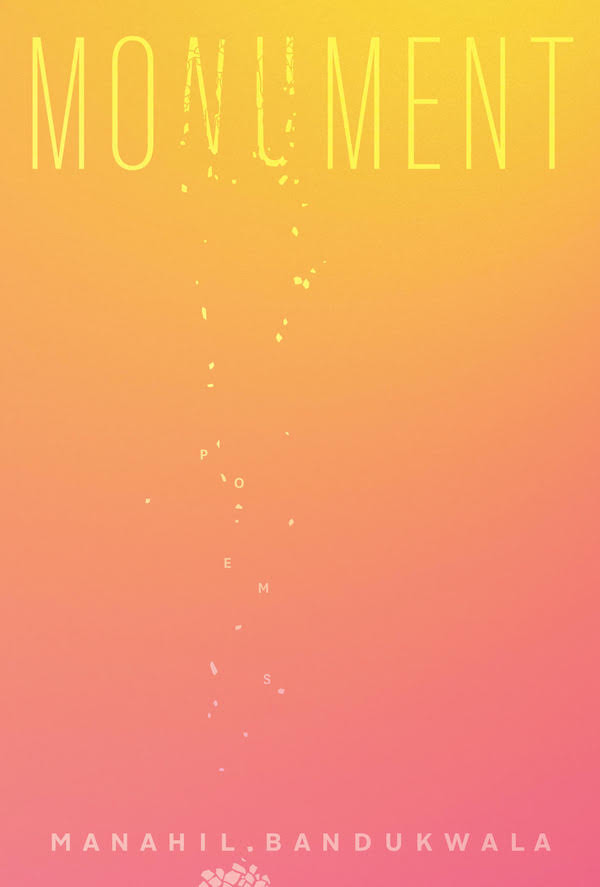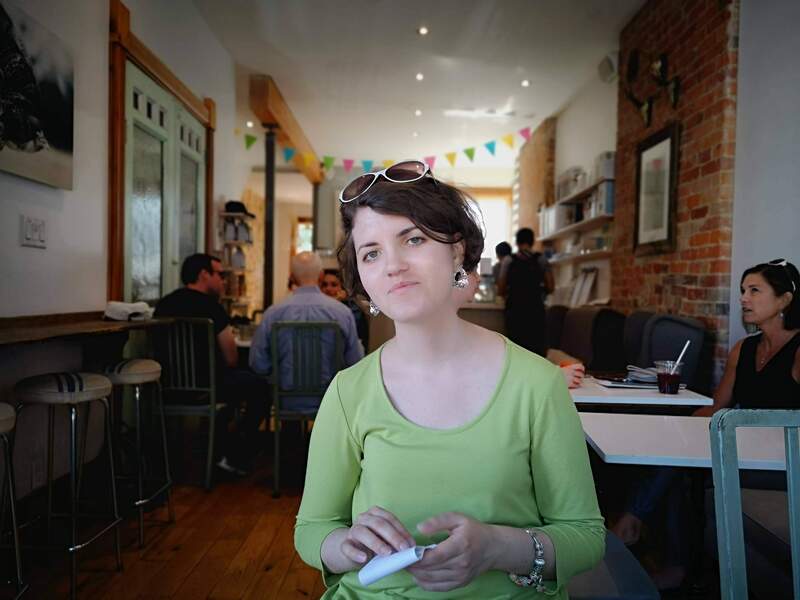|
|
The title of Manahil Bandukwala’s debut poetry collection is likely to bring up many associations, given the increased discussion in recent years between commemoration and oppressive systems of power such as colonialism. In fact, Monument is quite explicit in referencing a specific monument—the infamous Taj Mahal—which appears, inversed, between the sections of the collection, its form slowly crumbling with each iteration. Yet upon finishing Monument, the matter of definition remains open as it becomes less clear what a monument is.
In its aim of reclaiming the individual to whom the monument of the Taj Mahal was built—Mumtaz Mahal— Monument shifts the idea of monument from material to person, from a representation of to a self-fashioning into. Mumtaz Mahal is always at the center of Monument. More specifically, it is Arjumand Banu, the version of herself that she was born as and the version that she remained, often in private. The distinction between the names Mumtaz Mahal and Arjumand is significant. With the exception of the section titled Love Letters, in which the “you” addresses Mumtaz Mahal’s husband, Khurram (Shah Jahan), and the reader simultaneously, Bandukwala uses “you” to address Arjumand the woman rather than Mumtaz Mahal the historical figure, the footnoted name that continues to prop up the image of her husband through the architectural wonder he made for her. Arjumand’s body may have “beg[u]n a slow petrification” instead of “decompos[ing] into dust,” as Bandukwala writes in “Petrify,” but it is the “you” that prevents her from being completely subsumed, by the physical space that contains her remains, and also by the destructive capabilities of the current historical discourse. There is also a poetic and technical monumentality to Bandukwala’s collection that needs to be acknowledged, both because of how carefully it is researched but also how meticulously it is put together. Opening with a snapshot biography of Arjumand’s life, fact and emotion exist side by side in Monument as Bandukwala brings to life information that might otherwise feel cold and stagnant on the page of a history textbook. This is especially true of the section entitled “Offspring,” in which the poems are dedicated to those of Arjumand’s children who lived the longest: Jahanara, Dara Shikoh, Roshanara, Aurangzeb, and Gauharara. These individuals are humanized by nature of the fact that the poems are written to a mother about her children. Yet at no point does Bandukwala scrub her work of the personal, namely of her own relationality to the work. Bandukwala emphasizes the validity, even importance, of employing a more personal form of relationality when engaging with history. Bandukwala regularly addresses Arjumand directly, as in “Root,” promising her that, “if India/ lets me beyond its border […] I will fly to Burnhapur, to your first/ resting place.” Thus, Bandukwala’s speaker addresses Arjumand “as a poet,” asking about her preference for
The collection concludes with poems titled “Manahil” and “Mumtaz,” in that order. While Arjumand is, ultimately, the punctuation at the end of this text, it is Bandukwala who is there to facilitate the “shed[ding]” from Mumtaz to Arjumand. Bandukwala is not just writing to show Arjumand what kind of life she could have had. Instead, she is positioning herself as a listener, a believer in a reality where Arjumand had a more fulfilling life, with the Monument serving as a transcript rather than as another said-and-done document.
In this way, Monument has a dash of the epistolary. Bandukwala is speaking to Arjumand rather than to Mumtaz. The distinction between the two lies in the fact that Arjumand is not quite the past because she is an individual who was not allowed to fully come to pass, “to feel Agra heat for fifty years/more.” Bandukwala’s speaker is not a spiritual medium communing with a ghost, a being that is out of reach and cannot communicate without aid. Arjumand is instead waiting to be spoken to through the traces she has left behind, as Bandukwala has done with the erasure poem “Last Words?” Monument suggests that Arjumand is simply sitting in the next room, listening to advice from a friend and processing it before then forming her own response. Manahil Bandukwala’s poetry debut may be historical, yet it is also very much invested in leaving ripples in the present. Empire regularly comes up in Bandukwala’s poems, whether directly or by implication. One of the most evocative instances of this is in “1628,” where Bandukwala combines a critique of empire with what would be a postcolonial and material-focused reading of a work of art (in this case, the Taj Mahal) in the discipline of art history. Equally captivating is the poem “Restart,” which deserves individual attention for the way it combines historical material with contemporary pop culture, in this case Animal Crossing. “Restart” is more than simply a more allegorical approach to discussing the history of the Taj Mahal. It also stands out for the way it challenges the reader to consider how they think about what it means to engage with the past in a “meaningful way,” a term that is often thrown around to reinforce the Western myth of an objective and unbiased study of the past and of art. Monument is a living document, one that seeks to unmake more than it does to establish a counternarrative. For this reason, it is a collection that goes against one of the fundamental goals of humanistic studies like history—to constantly debate and contest and rewrite—and against the ideas that such critical discussions of history should occur at a remove from the subject, as if death is somehow a permanent barrier that prevents one from establishing connections with people across time and space. Margaryta Golovchenko (she/her) is first generation Ukrainian settler-immigrant, poet, and critic from Tkaronto/Toronto, Canada. She is the author of three chapbooks, most recently Daughterland (Anstruther, 2022). Her individual poems have appeared most recently in Sprawl Magazine, Talking About Strawberries All of the Time, Channel Magazine, and Prairie Fire, among others. She has written art and literary criticism for a variety of publications. She is currently a PhD student in the art history program at the University of Oregon.
|


